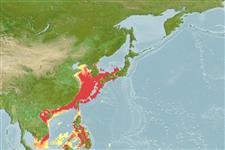Common names from other countries
Environment: milieu / climate zone / depth range / distribution range
Sinh thái học
Ở đại duơng, biển (Ref. 75927); Mức độ sâu 10 - 150 m (Ref. 275), usually 60 - 150 m (Ref. 75927). Subtropical; 15°C - 25°C (Ref. 75927); 41°N - 6°N, 104°E - 138°E (Ref. 1695)
Western Pacific: South and East China seas, Japan to Philippines and Indonesia.
Length at first maturity / Bộ gần gũi / Khối lượng (Trọng lượng) / Age
Maturity: Lm ? range ? - ? cm Max length : 18.0 cm ML con đực/không giới tính; (Ref. 275); Khối lượng cực đại được công bố: 600.00 g (Ref. 1695)
Caught by otter trawls, pound nets, hoop nets and hook-and-line (Ref. 346).
Life cycle and mating behavior
Chín muồi sinh dục | Sự tái sinh sản | Đẻ trứng | Các trứng | Sự sinh sản | Ấu trùng
Members of the class Cephalopoda are gonochoric. Male and female adults usually die shortly after spawning and brooding, respectively. Mating behavior: Males perform various displays to attract potential females for copulation. During copulation, male grasp the female and inserts the hectocotylus into the female's mantle cavity where fertilization usually occurs. Life cycle: Embryos hatch into planktonic stage and live for some time before they grow larger and take up a benthic existence as adults.
Roper, C.F.E., M.J. Sweeney and C.E. Nauen. 1984. (Ref. 275)
IUCN Red List Status (Ref. 130435: Version 2024-1)
CITES status (Ref. 108899)
Not Evaluated
Not Evaluated
Human uses
Các nghề cá: Tính thương mại
| FishSource |
Các công cụ
Các nguồn internet
Estimates based on models
Preferred temperature
(Ref.
115969): 11.6 - 23.2, mean 18.5 (based on 195 cells).
Prior r = 0.31, 95% CL = 0.20 - 0.47, Based on 1 full stock assessment.
Vulnerability
Low vulnerability (10 of 100).
